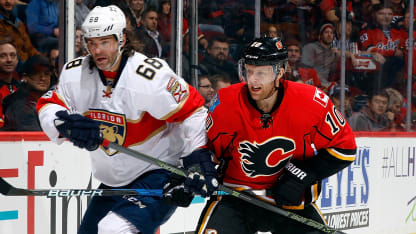The most remarkable aspect of Jagr's scoring in recent seasons is how effective he has been at 5-on-5. Playing primarily on the Florida Panthers' top line with Jonathan Huberdeau and Aleksander Barkov since he was acquired in a trade from the New Jersey Devils on Feb. 26, 2015, Jagr averaged 2.32 points per 60 minutes. That ranked eighth in the NHL among those to play at least 1,000 minutes, according to XtraHockeyStats.com.
Jagr could sustain that scoring level at 5-on-5 if he's on Calgary's top scoring line with Johnny Gaudreau (2.19) and Sean Monahan (1.97), but it could dip slightly if he plays on the third line with Sam Bennett (1.48) and Kris Versteeg (1.54), as expected.
On the other hand, Jagr's production could be even greater if he becomes a force on Calgary's power play. Jagr was second among Florida forwards with an average of 2:43 of power-play ice time per game (Barkov, 2:47) and had 28 power-play points (15 goals, 13 assists) in 181 games with the Panthers, tied for 87th among NHL forwards since Feb. 26, 2015. Among Flames forwards, only Gaudreau (45) and Monahan (44) had more power-play points in that span.
In terms of usage, Jagr certainly is an offensive-minded player, but he's not a defensive liability. Though he is not used to kill penalties, in his two-plus seasons with the Panthers, he faced top-six opponents and averaged 14:19 of even-strength ice time per game, fourth among their forwards. He started 739 shifts in the offensive zone and 718 in the defensive zone, for a fairly typical zone start percent of 50.72.
If there were any concerns about Jagr's defensive play in Florida, they didn't reveal themselves in his shot-based metrics. The Panthers outshot opponents 2,347-2,074 when he was on the ice, a shot attempts differential of plus-273, second among their forwards. To place it in relative terms, Florida's share of shot attempts increased from 48.9 percent when Jagr was on the bench to 53.09 percent when he was on the ice, for a relative SAT of plus-4.2 percent.
The only real risk is Jagr's age. Even though he has missed 20 games over the past six seasons, nobody can outskate Father Time forever.
However, Jagr's NHL salary cap charge is $1 million, minimizing that risk by giving the Flames the flexibility to find a replacement, should that become necessary. In fact, the entire projected line of Jagr, Bennett and Versteeg carries a combined cap charge of $4.7 million, according to CapFriendly.com, and could be one of the most cost-effective lines in the NHL.
Expect Jagr to contribute 43 points and help drive Calgary's shot-based metrics in the right direction.


















